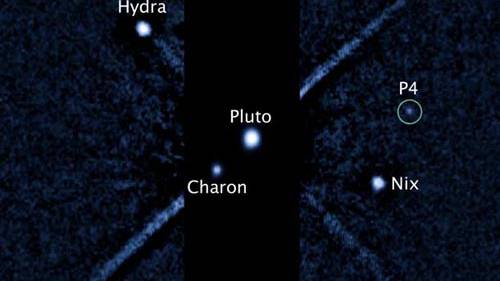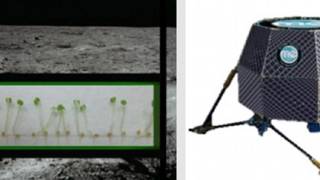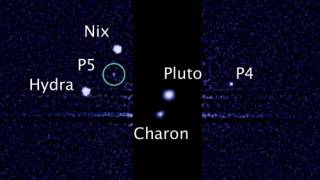Pluto has another moon!
Source: blogs.discovermagazine.com
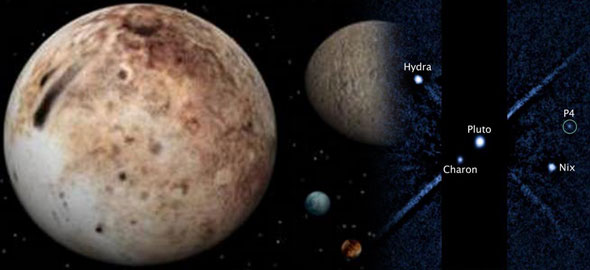
This is pretty nifty: astronomers have discovered a fourth moon orbiting Pluto!
The tiny chunk of ice was found in Hubble images taken just a few weeks ago, and was clearly seen among the three previously known satellites:
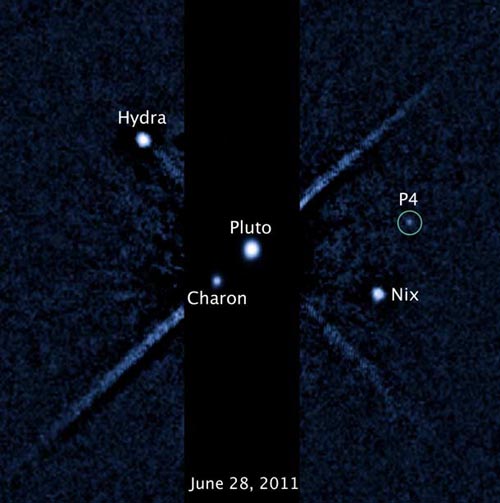
It doesn’t have a name yet — it’s designated S/2011 P1 (or just P4 informally) — and it’s only about 13 – 34 km (8 to 21 miles) across. The size is estimated by measuring its brightness and assuming it’s icy like Pluto itself — a more reflective (white or icy) object would appear brighter than a darker object if they are the same size. Since its actual reflectivity isn’t known, the size has a wide range. But it’s still pretty dinky. For comparison, Pluto itself is 2300 km across, and its biggest moon Charon is well over 1000 km in size. I’ll note our own Moon is 3470 km across, so even Pluto is pretty small.
The thing is, in that single image above you can’t be sure if the object is a moon or a coincidentally placed background star. The solution: take a second image! That was done, clinching the moon’s identity:
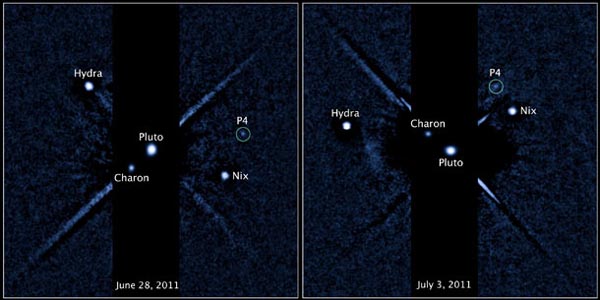
See how it’s moved? Mind you, in the week or so between these two images Pluto moved substantially compared to background stars, and the moon moved along with it around the Sun at the same time it’s going around Pluto. You can see the motion of the other moons as well.
In the image, the diagonal lines are an optical effect inside the telescope itself. Pluto is very bright, so the astronomers used some processing techniques to make it appear much fainter, taking multiple images and subtracting one from the other to remove the glare of Pluto (it doesn’t work perfectly, which is why there is a black strip across the image; that blocks unwanted noisy light). I did this myself on many images when I worked on Hubble. It’s amazing how well it works, as you can see in the image above.
Mind you, Pluto was 5 billion km (3 billion miles) from Earth when this image was taken! But we’ll soon get much better pictures: the New Horizons probe will fly past the tiny world in 2015, snapping away as it does. We’ll probably learn more about Pluto in a few hours than we have since its discovery in 1930.
I wonder what they’ll name this iceball? The two moons Nix and Hydra (discovered in 2005) were named after Roman mythological characters associated with night time and Pluto. Cerberus seems like an obvious choice, but there’s already an asteroid with that name. Maybe they can change the spelling a bit to Kerberus to get around that. There’s already an asteroid named Persephone, too, if you’re curious. We’re running out of good names!
Well, whatever it’ll be called, it’s there, and we’ll see it up close in personal in just a few more years.
Credit: NASA, ESA, and M. Showalter (SETI institute)
Article from: discovermagazine.com
From: SPACE.com
The finding is a result of ongoing work to support NASA’s New Horizons mission, which is scheduled to fly through the Pluto system in 2015. The mission is designed to provide new insights about worlds at the edge of our solar system.
Hubble’s photos of Pluto’s surface and the discovery of its satellites have been invaluable for planning for New Horizons’ close encounter.
"This is a fantastic discovery," said New Horizons’ principal investigator Alan Stern of the Southwest Research Institute in Boulder, Colo. "Now that we know there’s another moon in the Pluto system, we can plan close-up observations of it during our flyby."
Pluto’s moon system
The dwarf planet’s entire moon system is believed to have formed by a collision between Pluto and another planet-sized body early in the history of the solar system. The galactic smashup flung material that combined into the family of satellites observed around Pluto.
Our own moon is thought to have been created by a similar collision between Earth and a Mars-sized body 4.4 billion years ago. Lunar rocks that were returned to Earth from the Apollo missions led to this theory, and scientists think material blasted off Pluto’s moons by micrometeoroid impacts may form rings around the dwarf planet.
So far, Hubble’s photographs have yet to show any such rings, but the detection of P4 shows that big discoveries can sometimes be unexpected.
"This surprising observation is a powerful reminder of Hubble’s ability as a general purpose astronomical observatory to make astounding, unintended discoveries," Jon Morse, director of the astrophysics division at NASA Headquarters in Washington, D.C., said in a statement.
P4 was first seen in a photo taken with Hubble’s Wide Field Camera 3 on June 28. It was confirmed in subsequent Hubble pictures taken on July 3 and July 18. The moon was not seen in earlier Hubble images because the exposure times were shorter.
There is a chance that P4 appeared as a very faint smudge in images from 2006, but was overlooked because it appeared obscured, scientists said.
Pluto was discovered in 1930, but its planethood was thrown into question when the International Astronomical Union came up with a new definition of "planet" in 2006. That year, Pluto was demoted to the status of "dwarf planet," a newly created category to describe many other objects in the Kiper Belt, the ring of icy bodies beyond Neptune.
(Source)
